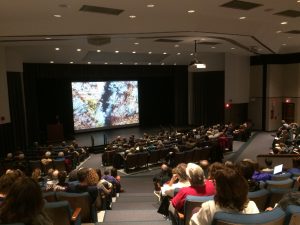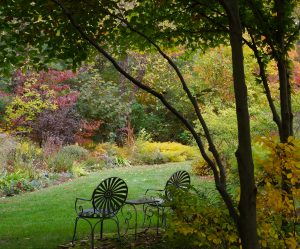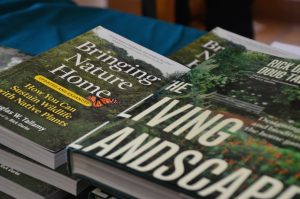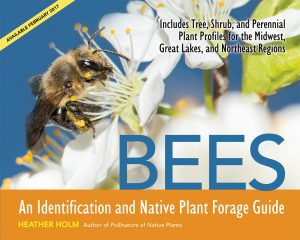
Thank you to everyone who attended the conference. We were pleased to be able to bring these two accomplished professionals to the Chicago area. Both of their messages were grounded in deep experience, were very practical, yet very inspiring. Rick Darke’s lecture was a wonderful and rare mix of philosophy, reflection, practical how-to advice, and humor. Heather Holm’s was grounded in science and concrete guidelines about easy ways to support pollinators and birds.
Darke began his lecture discussing how he learned to look at nature and through a series of photographs he took over the years, he made obvious the subtle nuances he observed in the daily landscapes he encountered, a lesson he exhorted us to follow. The most important places are right outside our doors.
As he explained how approaches design, he emphasized the need for patience and a desire to allow the garden take its own shape over the years. We can learn how to appreciate the interaction between our intentions/actions in a garden and nature’s ways (plants move themselves around and we should pay attention to where they go).
He emphasized the need not to be overly clean in a garden. In removing all of the plant material and leaves, we are removing beneficial insects as well as important natural mulch that feeds an astounding number and diversity of soil organisms.

He highlighted a Towhee scratching in his garden at the ground layer through the leaf “litter,” which would never find anything to eat in the typically sanitized garden where everything has been removed leaving the soil bare to the elements. He removes large stems in the spring, which is quickly done because the weather and natural decay has helped the process. It takes much less time and effort to clear an area in the early/late spring than it would to clear it at the end of summer.

Another facet important to his landscapes is the idea of organic architecture, which for him means creating rooms using appropriate trees, shrubs, and plants. His presentation illustrated how he approached this idea quite clearly.
He believes there should be no dichotomy between humans and nature. We need to see ourselves as part of nature, as part of natural processes, and make ethical choices in landscaping because we are part of the process, not separate from it.
Some of the plants he likes (they are all listed in his book): He mentioned Seedbox, Ludwigia alternifolia because of its fall color and interesting seed capsules. Many of us had not heard about it. Also used in his landscapes: dogwoods, viburnums, silverbells, Ironwood trees, winterberry, Bottlebrush Buckeye, and many more. A complete list of plants he uses and how he uses them can be found the book he co-wrote with Doug Tallamy The Living Landscape: Gardening for Beauty and Biodiversity.
Heather Holm’s presentation began with the important idea about the necessity of providing nesting habitats for pollinators and other insects which help out bird populations. When she creates a new garden, she ensures that wood logs are placed on the ground so that insects can use them as a nesting area (30% of our solitary native bees are cavity nesters) and as insects start to inhabit rotting logs, birds find food there. She gave the example of Pileated Woodpecker who used her yard and the rotting logs as a place to forage. Like Darke, she also mentioned the need not to clear out our gardens/landscapes by using conventional clean-up methods. Holm also recommends doing as little clean up as possible. In the spring, she creates what she calls “plant stubble” by cutting stems down to about 2 feet or so, usually the kind of plants that are hollow (cup plants, helianthus, eupatoriums, milkweeds), and soon small cavity nesting bees will find them and start creating nesting cells, provisioning them with “bee bread,” laying eggs, and finally sealing up the cavity.
She highlighted some of the most beneficial trees and shrubs for birds and pollinators. You can find many more details and suggestions in her wonderful new book which is richly illustrated with beautiful and clear photos. She thinks straight Red Maples should be planted more because they offer so much. They bloom early and native maples are hosts to many types of lepidoptera and many other types of wildlife use this tree. Other favorites, like Doug Tallamy, she also loves Black Cherry and research is finding that Hackberry is one of the most important and is resilient for climate change.
She was asked about native cultivars and their use in gardens. Holm says that while there are times when a cultivar might supply more nectar, that plants are about more than their nectar. She advocates for the use of straight native plants as much as possible. She says that research is showing natives are 4x more attractive to pollinators and insects.
Holm also reminded us that we do not have to have a prairie to support birds, bees, and butterflies. Prairies take maintenance. Her new book goes in depth into shrubs and trees that are important to pollinators, and these plants are ones that are very often neglected in our landscapes. Additionally, she has been working with farmers and trying to figure out the most beneficial shrubs and trees that they can plant and not worry about. For these situations, she has been finding shrubs like Grey Dogwood, willows, and sumacs good for these situations.

This brief write up cannot completely capture all of the wisdom, experience, and humanity of these two speakers. We recommend their books and trying to see them if you missed them.
It’s a lot of work to pull a conference off, and we did it with a small conference committee and many wonderful volunteers on the day of the conference. We thank you!
Thanks again to Triton College for hosting the conference. Thanks also again to attendees, to our members and to PlanItGreen for making this event possible.

